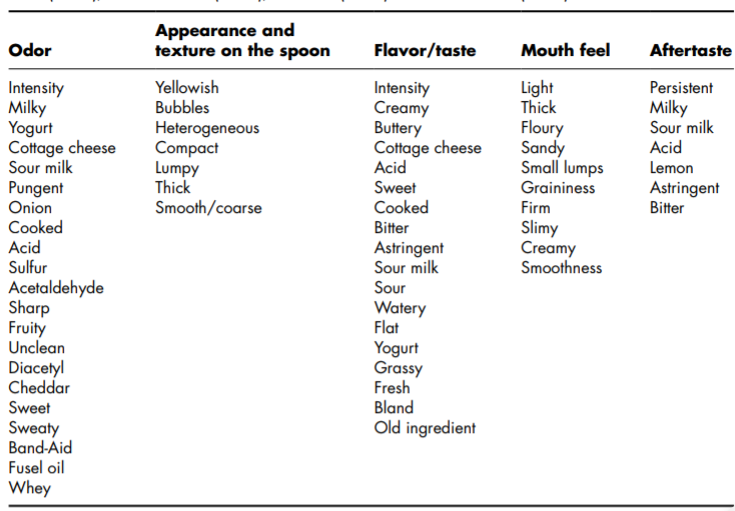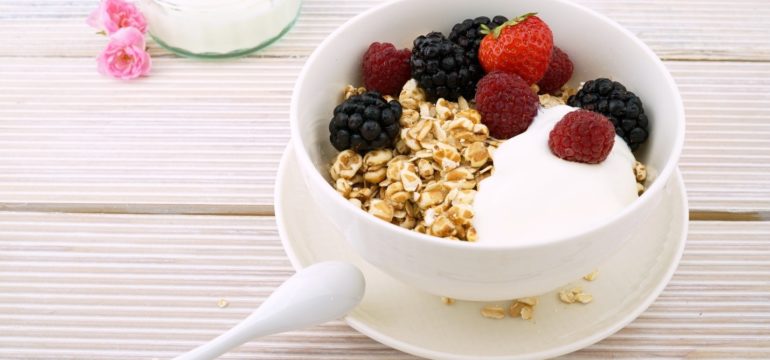BY: MEGAN KESLER & ELLIOT DHUEY
Introduction
With so many types of yogurt-like products occupying the shelves of supermarkets, it can be overwhelming to select which one to buy. In hopes of helping you narrow your scope of selection, we have divided these products into four general categories: traditional yogurt, Greek-style yogurt, Skyr, and yogurt alternatives. By learning a little about the origin of each one and their manufacturing processes, we can appreciate our selection at the supermarket. Additionally, we want to better understand how differences in manufacturing affect the consumer experience of each product. To do this, we are providing an opinion on some yogurt and yogurt-like products that we taste-tested.
Traditional yogurt
Legend has it that yogurt was created by happenchance in the slopes of Mount Elbrus where microorganisms that love higher temperatures (40-45°C) were combined into a pitcher of milk by a Turkish nomad. To this day, this product is made commercially to satisfy many hungry consumers. The bacteria in this product help to preserve it by lowering the pH, which inhibits the growth of other microorganisms that could be detrimental to the product quality and safety [2].
Yogurt is created from the fermentation of milk by lactic acid bacteria (Streptococcus thermophilus and Lactobacillus delbrueckii spp. Bulgaricus) [6]. These microorganisms convert lactose from the milk into lactic acid, which contributes to the unique tart flavor and thick texture of yogurt by gelation of the milk proteins. Milk is the ideal fermentation substrate for these lactic acid bacteria because it is composed of water, fat, protein, lactose, and minerals as well as enzymes, organic acids, nitrogenous compounds and over 100,000 other compounds because of its biological origin [3].
Yogurt is typically made commercially as either set type, stirred type, or drinking type. All types are manufactured using the same basic steps. First, the milk is heat-treated in order to make it more accessible to the bacteria. This will also make the milk firmer, and reduce whey separation [2]. Next, the milk is cooled, the starter culture is added, and the mix is incubated. In set type yogurt, the milk is incubated directly into the final packaged cups, whereas in stir type, it is incubated in a tank where additional ingredients can be added before filling into cups. Lastly, drinking type yogurt is homogenized to lower the viscosity [2].
Greek-style yogurt
Greek yogurt or Greek-style yogurt is yogurt made from skim, low-fat, or whole milk that has been strained to remove the whey. In the traditional method, yogurt, which is manufactured in the same way as regular yogurt, is placed in cloth bags and either pressed by hand or hung in a <10°C cooler until a sufficient amount of whey has drained away to achieve the desired total solids [3]. When manufactured commercially, the yogurt is concentrated using centrifugation or membrane filtration.
The whey removed from yogurt is called acid whey because of its low pH of 4.3-4.6 resulting from the yogurt fermentation process. Acid whey is approximately 94% water. Along with water, it also contains water-soluble components of milk including whey proteins, minerals, vitamins, lactose, and lactic acid. Since whey is mostly water, removing it concentrates the yogurt and the nutrients in it. Thus, Greek yogurt has a higher amount of protein per serving and has a creamier, thicker consistency.
Strained yogurt has been a part of traditional cuisine in numerous countries in the Middle East and Europe, probably for centuries. Strained yogurt was introduced to the United States by FAGE, a Greek dairy manufacturer, in 2000. Thus, in the U.S., strained yogurt has been called Greek yogurt, even though strained yogurts are not strictly a Greek food product.
Along with FAGE, Chobani is the other major Greek yogurt manufacturer in the U.S. that spearheaded the introduction of strained yogurt to the U.S. market. Both FAGE and Chobani make Greek yogurts that are strained. However, since the rise in popularity of Greek yogurt in the U.S., many other yogurt manufacturers have come out with Greek-style yogurts, not all of which are strained. Instead, the thicker consistency that is characteristic of strained yogurt can be achieved by adding in more milk solids (milk carbohydrates and proteins) and thickeners, such as pectin or carrageenan.
Skyr
Skyr originates from Iceland, where it has been made for nearly 1,000 years [1]. Skyr, like Greek yogurt, is a strained fermented dairy product. Although similar to yogurt because both use the same cultures, Skyr is technically a skim-milk cheese because it is made with rennet, an enzyme used to curdle the milk in cheese manufacturing. Along with the traditional yogurt cultures, Skyr is also fermented by yeast. Thus, the flavor profile of Skyr is slightly different than yogurt and consists of lactic acid, acetic acid, diacetyl, acetaldehyde and ethanol [3]. To make Skyr, skim milk is fermented with Skyr cultures at 40°C until a pH of 4.6, then is cooled to 18-20°C and is further fermented until a pH of 4.0 is reached. After fermentation, the Skyr is centrifuged using a clarifier-type separator to remove the whey.
Plant-based yogurt alternatives
The origins of yogurt alternatives are largely based on consumer demands, as consumers are seeking alternatives to dairy products including coconut, soy, oat, flax, hemp, rice and others. Because of consumer trends and dietary demands, the rise in dairy-free products has grown in the market. In 2017, plant-based yogurts increased 56% with a predicted global sale of $10.9 billion in 2019 [4]. In particular, coconut milk, which is the liquid that comes from the coconut meat, functions as a great alternative for fermented products because it contains water, fat, protein, carbohydrates and minerals, much like dairy milk. It is prepared in much the same way as traditional yogurt by pre-heating the milk, adding the bacteria after it has been cooled and then incubating [6] . Because of the difference in available nutrients between dairy and non-dairy foods, a starter culture that is able to ferment the carbohydrates in the plant must be selected. If the starter culture chosen is not suited to the plant, it may lead to a bad fermentation causing spoilage or even contamination with pathogens. Lactobacillus plantarum is one example of a starter culture that can be selected for fermentation of plant-based products. Additionally, enzymes can be added during the fermentation to increase the available fermentable carbohydrates [5].
Sensory Evaluation of Yogurt-Like Products
We used the sensory descriptors shown in Figure 1 to guide our evaluation of various yogurt and yogurt-like products that we purchased from the local supermarket. For each product, we covered each attribute: odor, appearance, flavor/taste, mouthfeel, and aftertaste. Lastly, we discussed our overall impressions of the products.

Figure 1. Sensory Descriptors used for characterizing fermented milks and yogurts (from Chandan et al. 2013)
Traditional yogurt
The traditional yogurt was your standard yogurt. Nothing to write home about, but not bad either. A strong yogurt aroma overtook our senses upon opening the package. After smelling that delightful aroma, the next thing we noticed was that the yogurt had a lumpy appearance. As unflattering as that was, it was also watery, shiny and had the semblance of cottage cheese. However, despite its unappealing exterior, the flavor of the yogurt was acceptable. The most notable flavor notes were acid and a nondescript yogurt flavor. The mouthfeel was also not bad, although it was somewhat lumpy and just a tad slimy. Finally, the yogurt left a strong acidic aftertaste. Overall, this yogurt was what you would expect an inexpensive, traditional yogurt to taste like. While it did not specifically offend us in any way, it was certainly not something we would intentionally seek out.
Greek yogurt
Strained
After opening the package, we questioned its freshness due to the sour-milk odor. The appearance was thick, compact, and coarse; we could tell this was going to be a mouthful. The yogurt had no problem sticking to the spoon – making transferring it to our mouths even easier. The taste was creamy and acidic but less “yogurt-y” than the traditional yogurt. We also noticed that this yogurt was quite astringent a.k.a. it was drying our mouths out with each bite. The mouthfeel was very thick and smooth, which contributed to a very pleasant eating experience. As Mary Berry would say (we see you, GBBO fans), it was scrummy.
Additive Thickened
This yogurt was thickened with tapioca starch and gellan gum. Thickeners can vary between yogurt type based on the function the manufacturer wishes to achieve. The odor of the yogurt was mild, and the curd was very smooth and shiny. But as they say, you shouldn’t judge a book by its cover. Despite its rosy exterior, the interior lacked character. The flavor was also mild (not as acidic as traditional) and lacked distinct yogurt notes. The texture was very light and smooth, but was also slightly gluey and stuck to our mouths as we tried to eat it. If you want to eat a Greek-style yogurt, strained, in our opinion, is definitely the way to go.
Skyr
To be fair, we need to note that Skyr is not technically a yogurt, but for the sake of this article, we judged it as if it were. It was cheesy; we are from Wisconsin so we know CHEESY. Aroma aside, its appearance was similar to the strained Greek yogurt, making it pleasing to the eye. The flavor of Skyr was very sour, and we mean SOUR! If it weren’t for that, we probably would have actually liked this product. It had a fantastic, smooth and creamy texture, and the finish was refreshing and lemony. Definitely a product you should try, but maybe it’s better not to expect something similar to yogurt when you do.
Yogurt Alternatives
Almond milk
The aroma of this product was chocolatey, even though it was vanilla flavored. The color was tan and the surface was shiny. The flavor was sickly sweet, but otherwise was similar to almond milk with strong almond and woody flavors. The slight sourness that came through seemed like a failed attempt to mimic real yogurt. Finally, the mouthfeel was extremely light and lacked the complexity of traditional yogurt.
Coconut milk
Compared to the almond milk, this yogurt alternative looked more like traditional yogurt. Its aroma was pleasantly sweet with a coconut tone. The appearance could have had some improvement as it had a shiny, translucent halo to it, similar to gravy. Additionally, it was yellowish, smooth, and had low viscosity. However, anything good about this yogurt alternative stops as soon as it enters your mouth. The chalky, floury, and slimy texture was accompanied by a dirty, bitter, and possibly plastic flavor. This “treat” was finished by a bitter, rice aftertaste.
Overall, these plant-based yogurt alternatives have a long way to go before being on the same playing field as yogurt. However, in the case of the almond milk yogurt alternative, we applaud their attempt. These products do hold a place in the market for those who cannot consume dairy and we hope to see more development to imitate yogurt in the future.
Conclusion
We hope that the background given on yogurt processing will help you better understand the options available to you at the supermarket. Furthermore, we hope that rather than taking our word for it, our taste tests encourage you to be adventurous and try some of the many new yogurt-like products that continuously enter the market.
References
[1] Anonymous. “What Is Skyr?” Icelandic Provisions, www.icelandicprovisions.com/what-is-skyr/.
[2] Bylund G (2003) Dairy processing handbook. Tetra Pak Processing Systems AB
[3] Chandan RC, Kilara A, ebrary, Inc (eds) (2013) Manufacturing yogurt and fermented milks, 2nd ed. Wiley-Blackwell, Chichester
[4] FONA International (2018) Non-Dairy Yogurt: 2018 – Trend Insight Report. FONA International
[5] Luana N, Rossana C, Curiel JA, et al (2014) Manufacture and characterization of a yogurt-like beverage made with oat flakes fermented by selected lactic acid bacteria. International Journal of Food Microbiology 185:17–26. doi: 10.1016/j.ijfoodmicro.2014.05.004
[6] Yaakob H, Ahmed N, Khairunnisa Daud S, et al (2012) Optimization of ingredient and processing levels for the production of coconut yogurt using response surface methodology. Food science and biotechnology 21:933–940. doi: 10.1007/s10068-012-0123-0







Leave a Reply